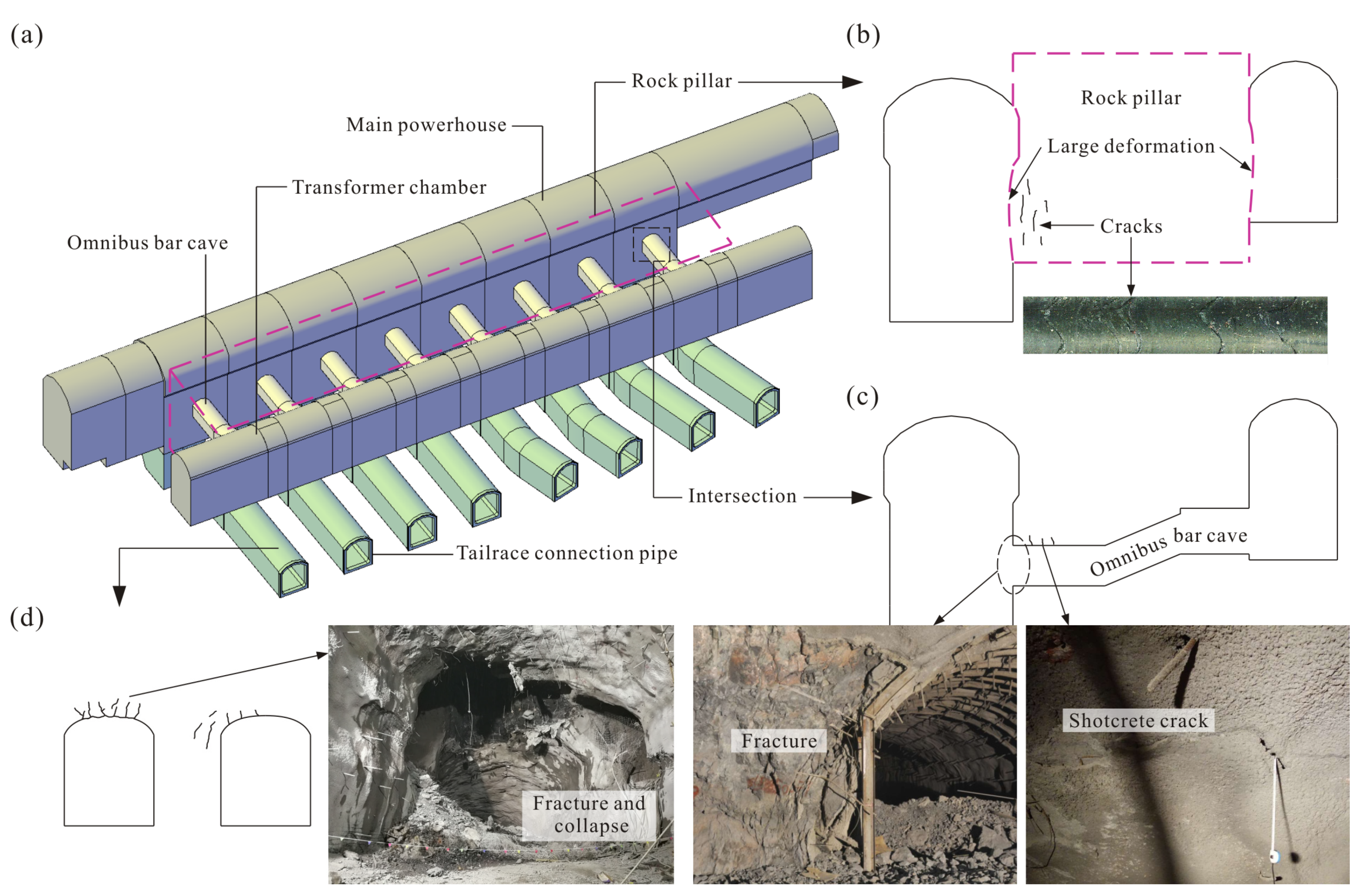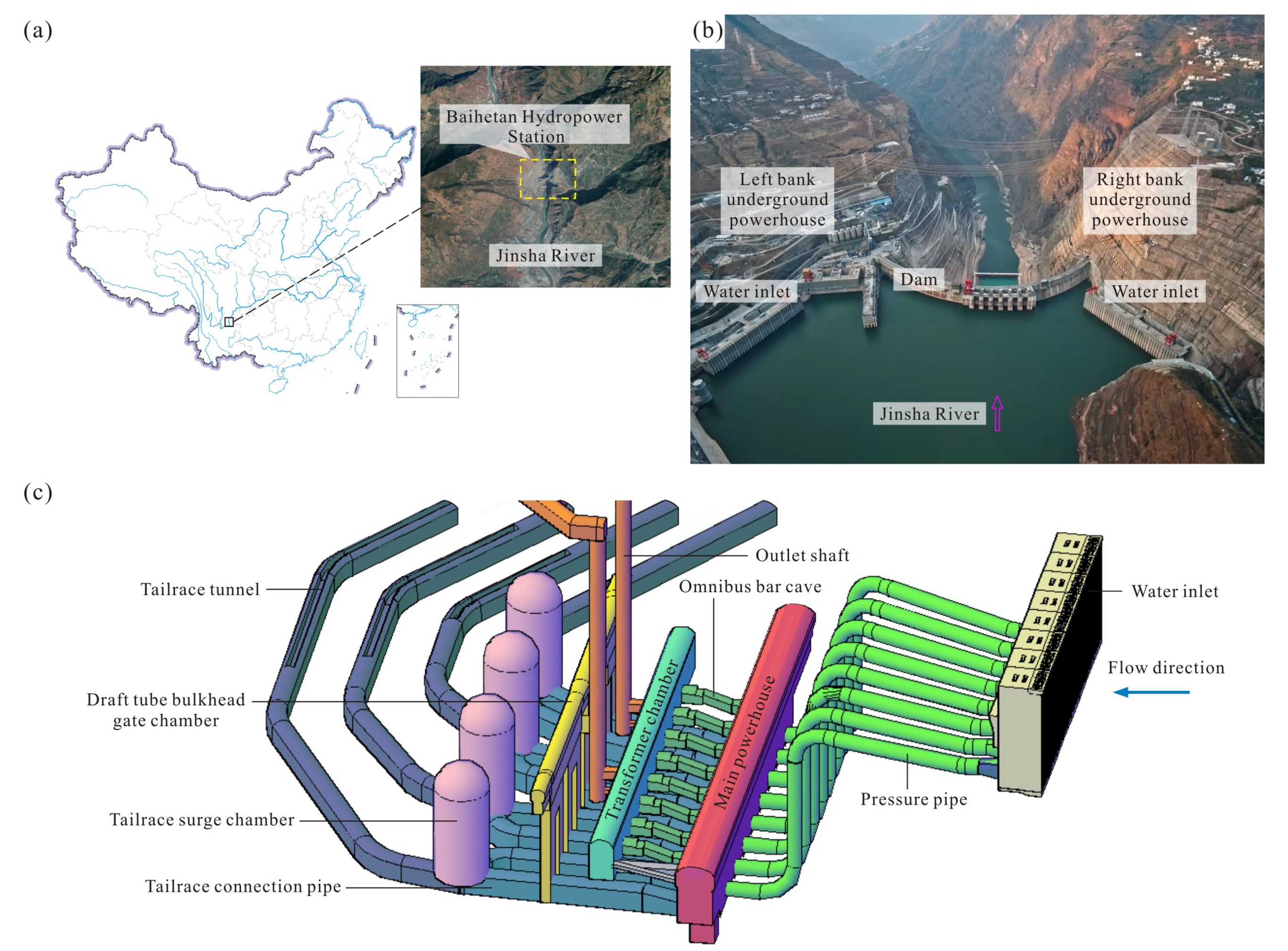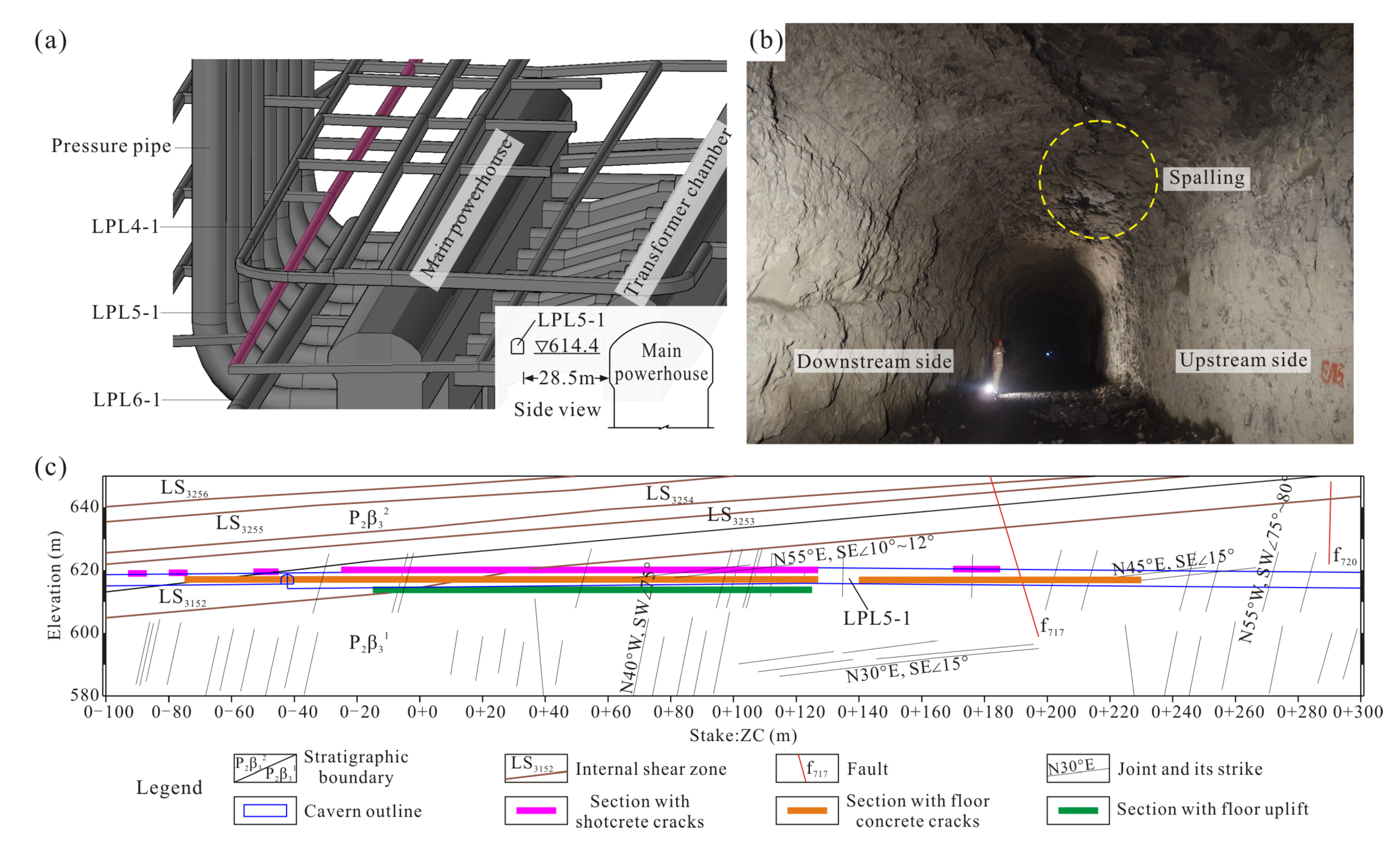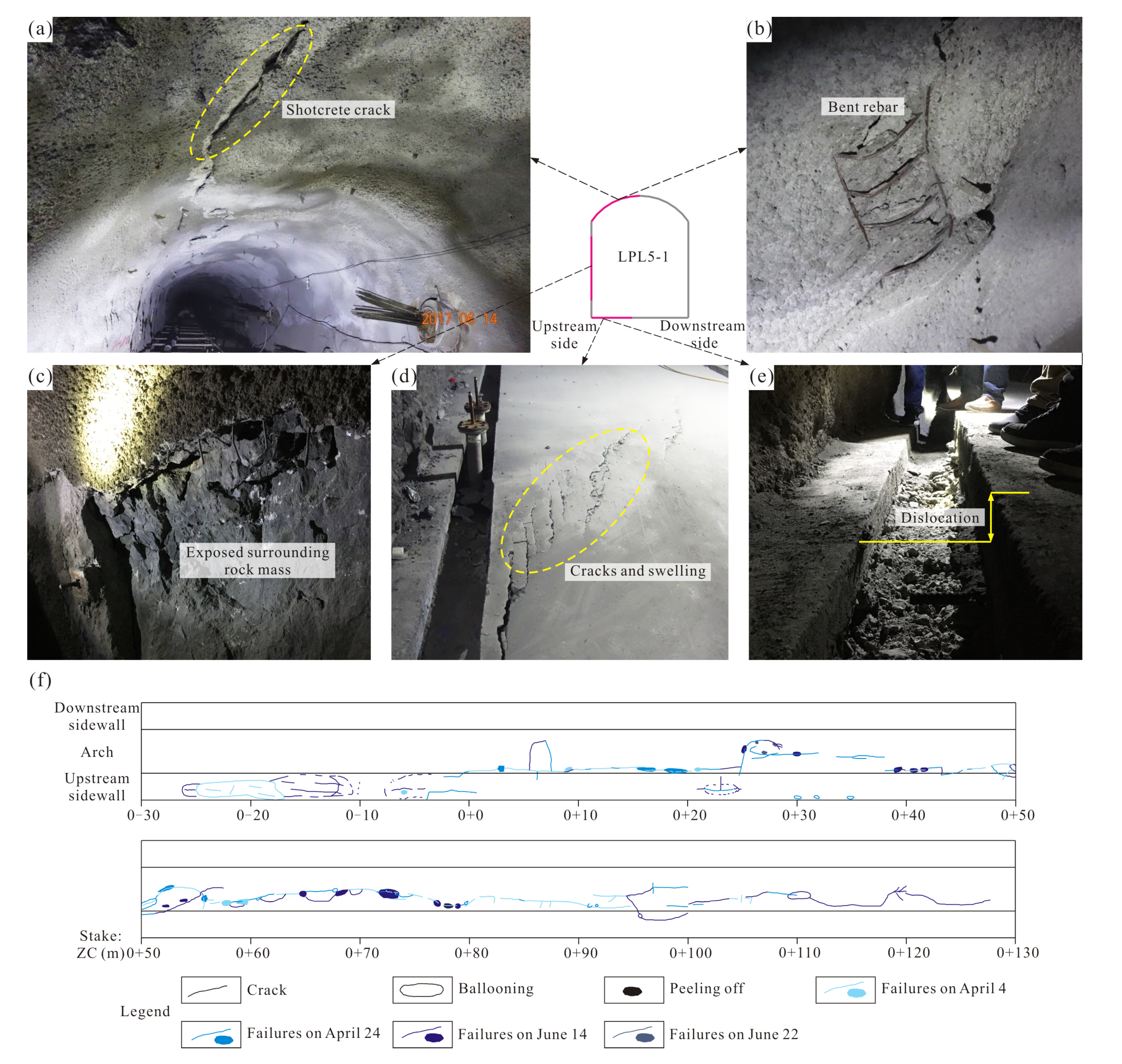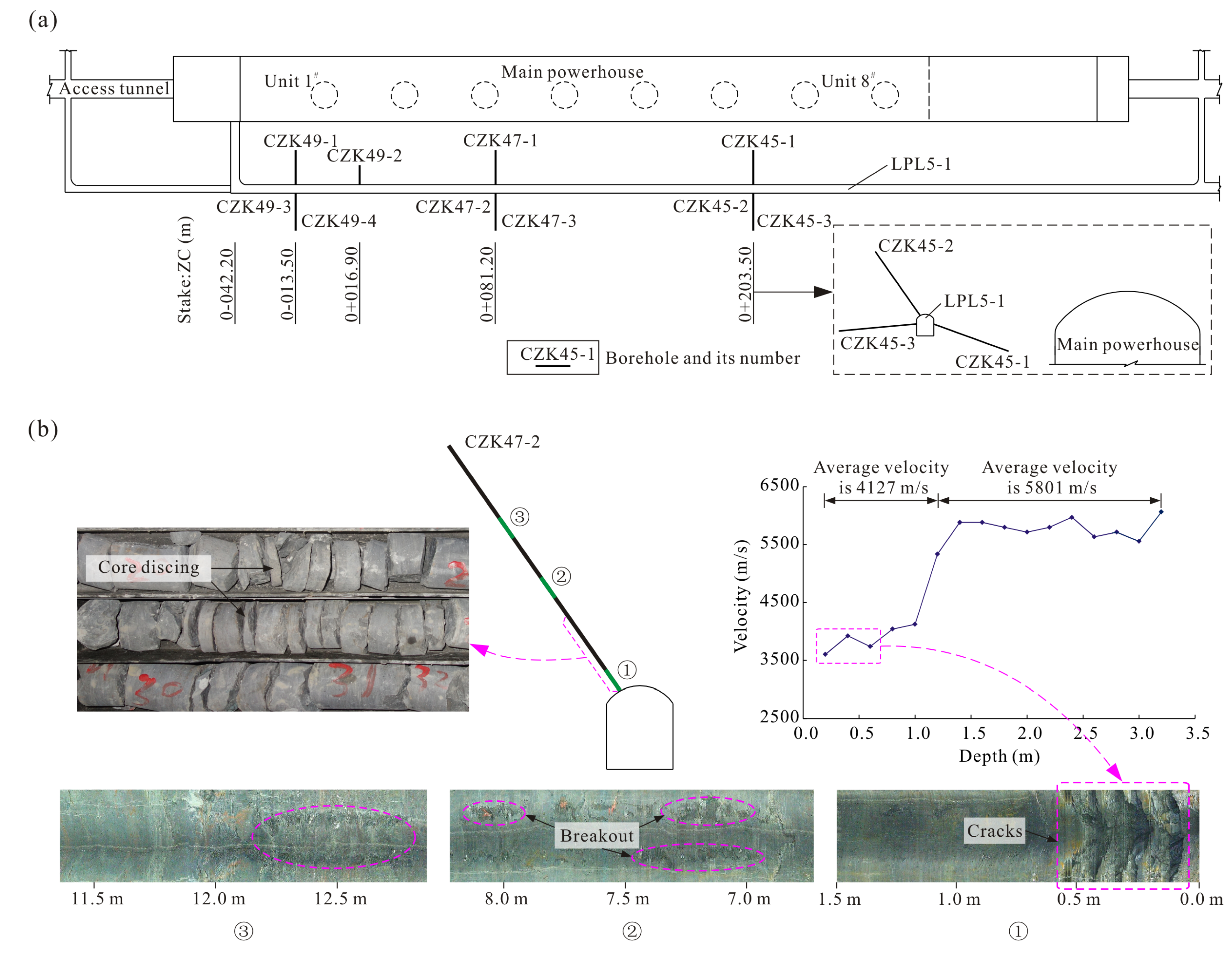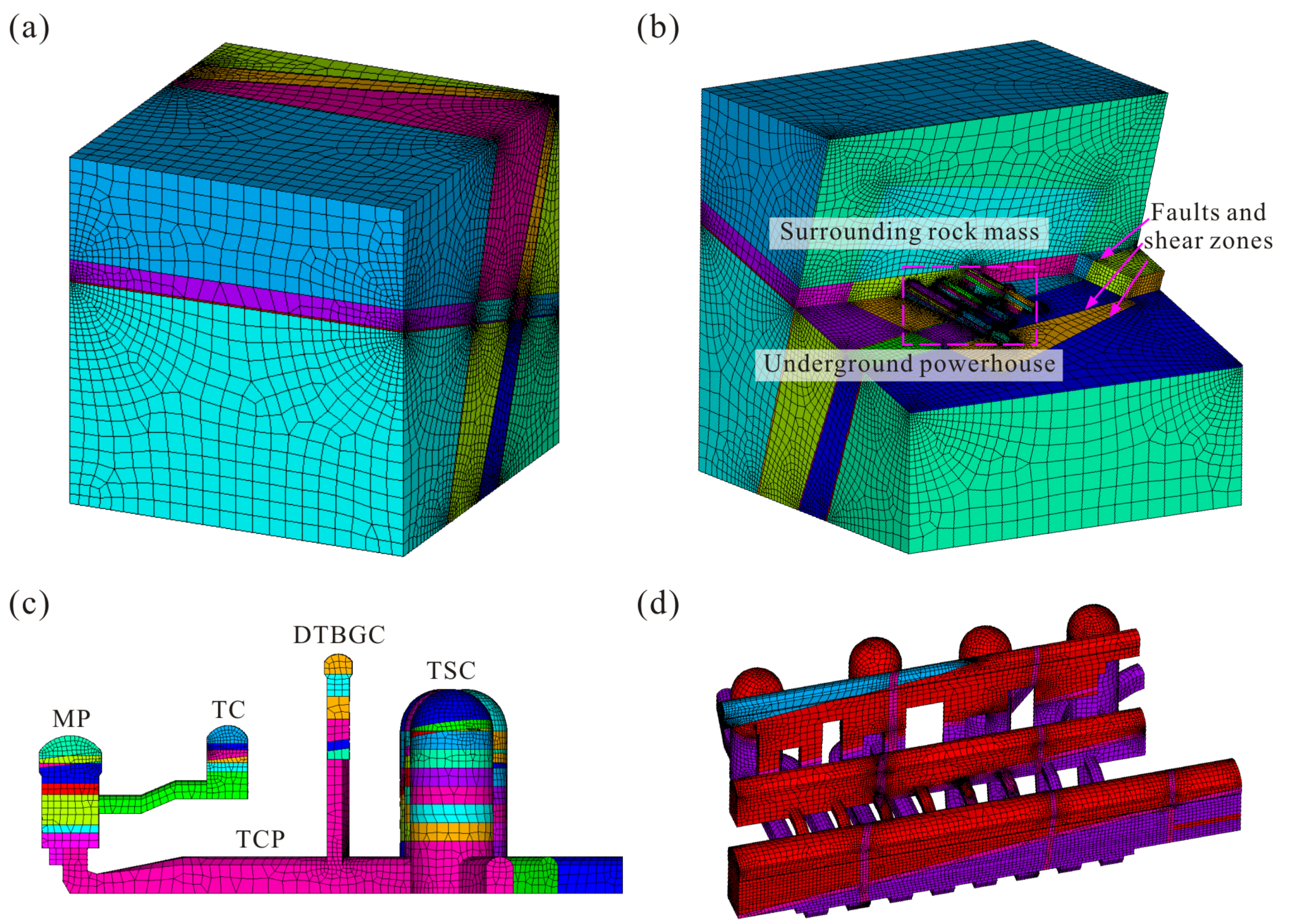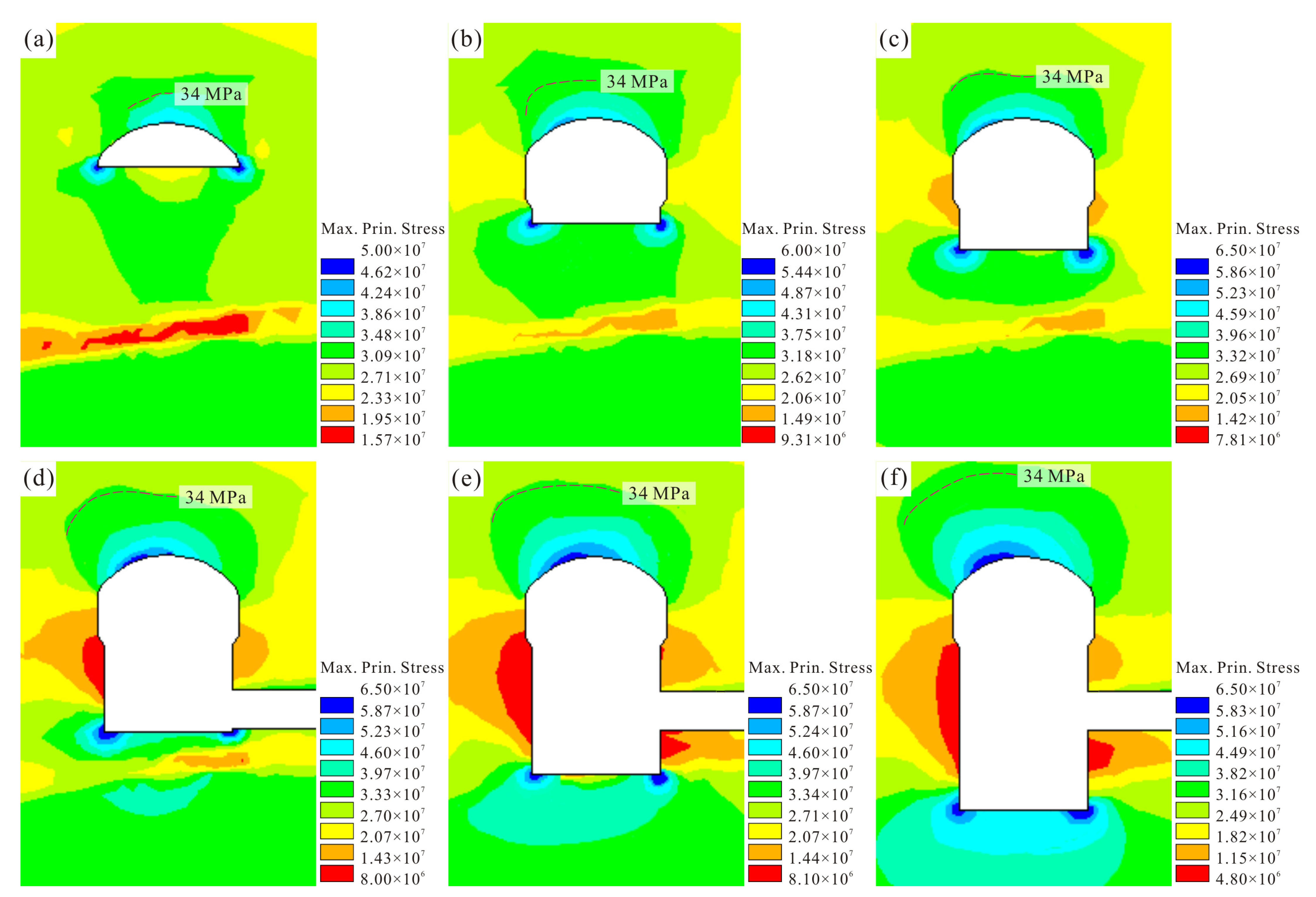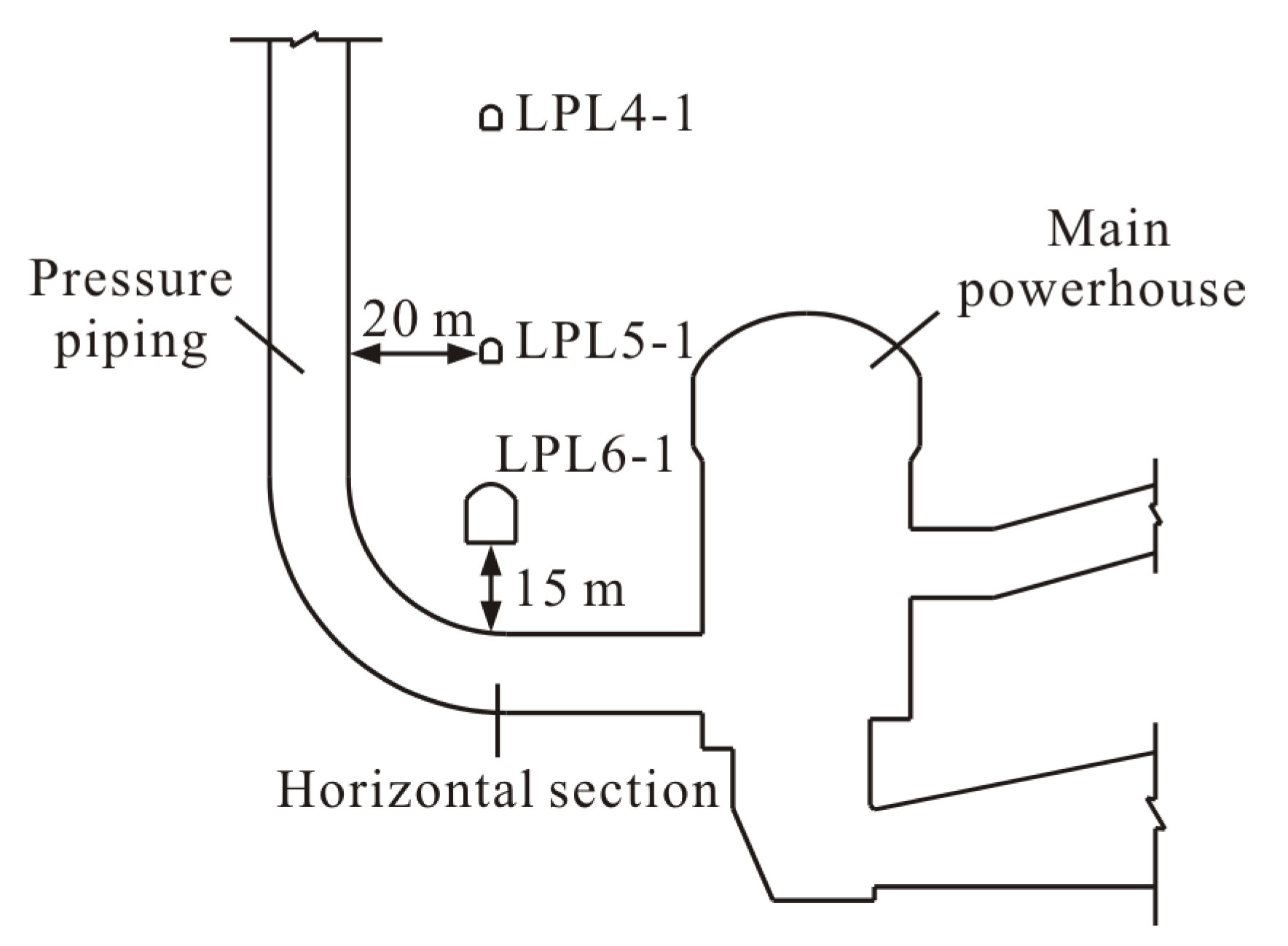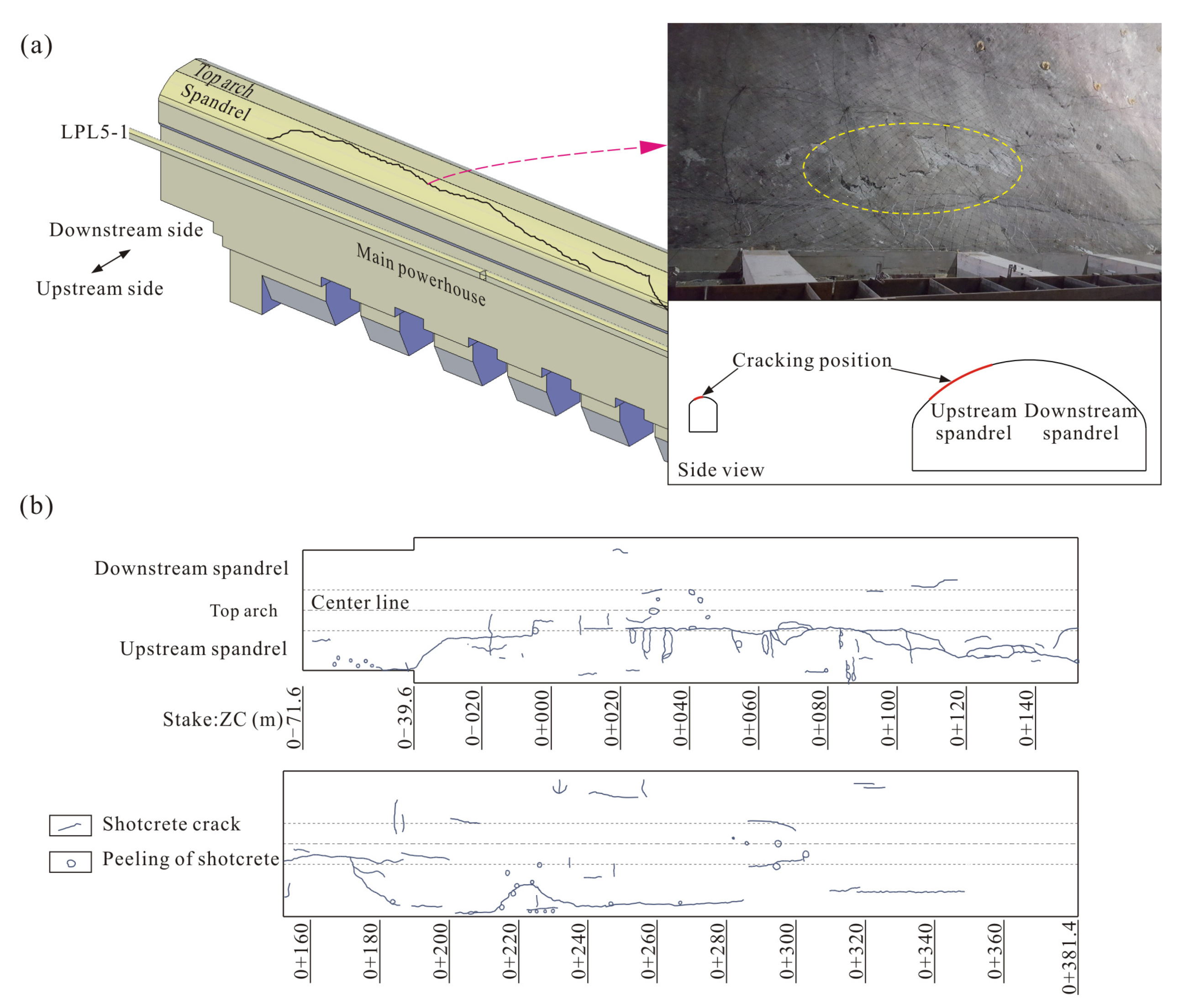1. Introduction
In order to meet the challenges of climate change and energy demand, many large hydropower stations have been under construction or put into operation in southwest China, which has nearly 60% of the waterpower resources of the country. Due to the limit of topography, underground powerhouse structures are usually utilized in these hydropower stations in the form of cavern groups inside bank slopes. These underground powerhouses are generally on a large scale and contain many different kinds of caverns and tunnels. As an underground powerhouse is the key structure of a hydropower station, its safety and surrounding rock mass stability are crucial. Subjected to the high in situ stress and complex geology in the mountainous area in southwest China, many deformation and failure issues of surrounding rock mass arise during the construction of underground powerhouses, such as rockburst, spalling, splitting, large deformation and collapse [
1,
2]. These failures and hazards not only threaten the safety of constructors and facilities but also cause economic losses in dealing with them. Therefore, the deformation and failure of surrounding rock mass is a key technical problem in the construction of underground powerhouse to which attention is always paid.
Since the powerhouse is an engineering structure built underground, the properties of the surrounding rock mass are of considerable significance regarding the safety and stability of the underground powerhouse, which is mainly reflected in the strength and structure of the rock mass. On one hand, the underground powerhouse with a large burial depth is usually subjected to high in situ stress; thus, the surrounding rock mass has relatively low strength after excavation. In such circumstances, the contradiction between in situ stress and rock mass strength becomes prominent and high stress can lead to the failure and large deformation of the surrounding rock mass. On the other hand, the geological structure in the rock mass provides a requisite for the deformation and failure. For example, under the combined cutting of structural planes, the surrounding rock mass is likely to collapse after cavern excavation. Thus, the characteristics, mechanisms and countermeasures of the surrounding rock mass deformation and failure are critical technical problems with respect to rock mechanics in the underground engineering field.
On the deformation, failure and stability of the surrounding rock mass, extensive research works have been performed at home and abroad and many valuable and meaningful results have been achieved. Ding et al. [
3] analyzed the deformation and cracking characteristics of the surrounding rock mass in the Wudongde underground powerhouse and proposed an optimized support scheme. The results of numerical simulation based on a constitutive model for a layered rock mass provided reference for the support design. Zhou et al. [
4] investigated four mechanisms of deformation and failure of steeply dipping layered surrounding rock mass, including unstable rock blocks, failure on the upstream sidewall, shotcrete cracking at the downstream roof and structurally controlled failure on the central pier. Based on in situ microseismic (MS) monitoring experiments, Xiao et al. [
5] analyzed the macro-failure characteristics, micro-failure modes and micro-seismicity of a stress-structure controlled collapse and explained its evolution mechanism. With the methods of MS monitoring, conventional monitoring and a three-dimensional distinct element code (3DEC), Hu et al. [
6] studied the effect of discontinuities and dynamic construction on the failure mechanism of surrounding rock mass and conducted a stability analysis of an underground powerhouse in a high geostress environment. Wang et al. [
7] investigated the failure mechanism of blocks in the collapse area of a tunnel by adopting a method of discontinuities’ automatic identification and stability analysis based on terrestrial laser scanning. In regard to the rockburst hazard under high in situ stress, Liu et al. [
8] predicted an intense rockburst and identified the location at a deep-buried tunnel with complex geological structures by employing a MS monitoring system. Xue et al. [
9] predicted rockburst in an underground powerhouse with a new method based on the rough set theory and the extension theory.
With respect to the stability assessment of surrounding rock mass, Wang et al. [
10] presented a practical flowchart of rock mechanics modeling for the steps in the evaluation process of an underground powerhouse. Based on the flowchart, stability analysis using the distinct element method (DEM) was conducted on three underground powerhouses. Kumar et al. [
11] conducted a dynamic stability evaluation against the excavation-induced stress adjustment on a large underground powerhouse and identified potential risk zones. Li et al. [
12] proposed a novel dynamic method for the stability evaluation of sidewall subjected to flexural toppling, which integrates stability criterion, continuum modeling and MS data. Ren et al. [
13] established a comprehensive safety evaluation method of surrounding rock mass, which combines a deformation stability prediction and evaluation method, a rapid prediction method of collapse and a comprehensive early-warning index system. Zhang et al. [
14] developed a novel rock mass displacement back-analysis method considering the displacement loss and applied it in the caverns of the Jinping II hydropower station and the Taian pumped storage power station.
In these studies, new techniques (including MS monitoring) were employed and a combination of multiple technical methods became a typical feature. According to actual engineering demands, previous research has explained the reasons and mechanisms of deformation and failure phenomena. In addition, the stability of surrounding rock mass in underground powerhouses has been comprehensively assessed via a variety of methods.
Compared with other underground openings, the underground powerhouse of a hydropower station is characterized as large scale with a large span, a high sidewall and complex structures. In terms of excavation dimensions, some underground main powerhouses are more than 200 m long and more than 60 m high and have a span of over 25 m. As for spatial structure, the underground powerhouse has many caverns of different functions and sizes. Large caverns include the main powerhouse, the transformer chamber and the tailrace surge chambers. Relatively small caverns include diversion tunnels, omnibus bar caves, tailrace tunnels and auxiliary caverns, such as construction adits and access tunnels. These characteristics have an impact on the surrounding rock mass stability of an underground powerhouse. When the excavation dimension is large, the long-lasting excavation disturbance can increase the risk of surrounding rock mass deformation and failure. With the number of caverns increasing, a multi-cavern effect is likely to appear when adjacent or intersecting caverns are excavated simultaneously, leading to surrounding rock mass instability. Consequently, the large scale and complex structure gives the underground powerhouse unique surrounding rock mass stability issues, which are relatively rare in other engineering structures such as traffic tunnels.
Among these issues, the deformation and failure induced by the multi-cavern effect is typical. The multi-cavern effect is the interaction between adjacent or intersecting caverns during the construction period. When a cavern is excavated, the stress in rock mass close to the free face is unloaded and the stress within a certain range around the cavern is adjusted. With the adjustment and redistribution of stress, the surrounding rock mass exhibits some mechanical behaviors, including deformation, damage and even failure. If there is a cavern adjacent to this cavern, the excavation, stress adjustment and rock mass responses of the two caverns may affect each other. When the interaction is obvious, the rock mass surrounding the caverns is apt to be damaged or to fail. For the large-scale underground powerhouse built in a limited space, extensive excavation blasting and multi-procedure construction will inevitably increase the possibility of interactions between the caverns, thus leading to deformation and failure.
The deformation and failure of surrounding rock mass induced by the multi-cavern effect in an underground powerhouse can be divided into three types: between large caverns (type LL), between a large cavern and a small cavern (type LS) and between small caverns (type SS). The deformation and failure of a rock pillar between the main powerhouse and the transformer chamber belongs to type LL (
Figure 1b). The deformation and failure of a small cavern affected by a large cavern such as the main powerhouse belongs to type LS (
Figure 1c). Deformation and failure under the impact of adjacent or intersecting small cavern belongs to type SS (
Figure 1d). The underground powerhouse usually has many caverns and a compact layout, and the multi-cavern effect is likely to occur during construction. Importance should be attached to the deformation and failure of surrounding rock mass induced by the multi-cavern effect; its reasons and mechanisms should be studied and explained and countermeasures be put forward to ensure the construction safety and long-term stability of the powerhouse.
However, previous studies have rarely focused on failure issues triggered by the multi-cavern effect; this is a research gap at present. This issue usually arises in the underground powerhouse with a large scale and complex spatial structure, which is different from a single cavern. Few cases have been reported so far and not much attention has been paid to this issue. This issue has occurred in a few projects, while previous studies have rarely conducted in-depth analysis on it. The main patterns, characteristics and mechanisms of the multi-cavern effect have not been systematically summarized. For the underground powerhouse of a hydropower station or a pumped storage power station, the deformation and failure of surrounding rock mass caused by the multi-cavern effect is likely to be prominent during construction. With the scale and burial depth of underground powerhouse increasing and the geological conditions becoming more complex, the importance of this issue will be further highlighted. Hence the multi-cavern effect in underground powerhouses is of great practical significance and is worth further study.
The surrounding rock mass failure of the drainage gallery LPL5-1 in the underground powerhouse of the Baihetan hydropower station is a typical case. After excavation and systematic support, the surrounding rock mass of LPL5-1 cracked and failed constantly; this has drawn much attention. The remarkable failure problems in LPL5-1 challenged the surrounding rock mass stability and the builders were worried about the construction and long-term operation safety of the drainage gallery. After failures occurred, builders were eager to find out the cause, evolution, mechanism and countermeasures of failures, and a large number of field investigations and feedback analysis were carried out. It is of significant importance to clarify the failure mechanism for the dynamic adjustment and stability control, which has become a key technical problem restricting the construction of this project due to its uniqueness and complexity. In this paper, the drainage gallery LPL5-1 is considered as a case study. Firstly, by field investigations, the failure characteristics are described. Next, based on numerical simulations, the stress evolution induced by excavation is studied. Then, the correlation between LPL5-1 and the main powerhouse is discussed. Finally, the mechanism of failures is analyzed.
4. Mechanism Analysis
LPL5-1 is situated in relatively good geological condition. The surrounding rock mass is hard and relatively intact and there is no geological structure that can threaten the surrounding rock mass stability. Judging from the failure pattern and location, shotcrete and floor concrete failures in LPL5-1 belong to the stress-dominated type; the geological structure is not a major affecting factor. The in situ maximum principal stress here is 19–23 MPa. When LPL5-1 was excavated, only mild spalling occurred and the surrounding rock mass could have remained stable after systematic support. Why did the failures develop continuously after support? The failures are likely to derive from other nearby caverns, not from LPL5-1 itself.
As reflected in
Figure 4a, the caverns around LPL5-1 are LPL4-1, LPL6-1, pressure piping and the main powerhouse. LPL4-1 is above LPL5-1 and has similar excavation dimensions to LPL5-1. The distance between LPL4-1 and LPL5-1 is over 30 m, which exceeds five times the section radius, and the stress adjustment by LPL4-1 excavation was unlikely to have so wide a range that LPL5-1 could be affected. LPL6-1 is also far away and the excavation disturbance has difficulty influencing LPL5-1. The pressure piping is at the upstream side of LPL5-1 and is 20 m away from it, with a section size larger than that of the drainage gallery. However, it is improbable that the pressure piping excavation brought about the failures in LPL5-1. The reason for this inference is as follows.
As shown in
Figure 9, the pressure piping is also at the upstream side of LPL6-1, with a distance of 20 m. At the lower horizontal section, the vertical distance between the top arch of pressure piping and the floor of LPL6-1 is about 15 m. LPL6-1 is adjacent to the pressure piping at the upstream and lower side and has a smaller distance than LPL5-1. Hence LPL6-1 is closer to the pressure piping than LPL5-1. Generally, the interaction with respect to rock mass behavior caused by cavern excavation and stress adjustment occurs between adjacent or intersecting caverns and the interaction becomes more significant if the caverns are closer. This has been proven in engineering practice and numerical simulations. If the excavation of pressure piping had an impact on the adjacent caverns, the most obviously affected cavern was LPL6-1. Namely, LPL6-1 should have encountered more serious surrounding rock mass and shotcrete failures than LPL4-1 and LPL5-1. The justification is that the stress adjustment induced by pressure piping excavation will first affect a closer cavern. However, the actual severity of shotcrete cracking in LPL6-1 is much lower than that in LPL5-1. Therefore, the pressure piping excavation is not the controlling factor for the failures in LPL5-1.
The main powerhouse is 28.5 m apart from LPL5-1. Although the distance is also large, the stress adjustment from the main powerhouse excavation has a large range due to the large dimensions and long-lasting excavation. So LPL5-1 can be affected by it. For other large caverns, the longer distance makes it less likely for them to influence LPL5-1.
When the shotcrete in LPL5-1 cracked, the sidewalls of the main powerhouse were excavated. The surrounding rock mass stress was in dynamic adjustment and had the potential for influencing adjacent caverns. In terms of failure evolution, there is a connection between the failure development in LPL5-1 and the excavation progress of the main powerhouse. Hence, we can preliminarily conclude that the failures in LPL5-1 resulted from the stress adjustment induced by the main powerhouse excavation. In the following section, the correlation between the failures in LPL5-1 and the main powerhouse excavation will be deeply analyzed in four aspects: failure pattern, failure time, stress adjustment and failure evolution.
- 1.
Correlation in failure pattern
Failure forms in LPL5-1 cover cracking, ballooning and peeling of shotcrete, as well as rebar bending toward the free face. These phenomena indicate that the surrounding rock mass here was subjected to high tangential stress. Similarly, cracking, ballooning and peeling of shotcrete also occurred at the upstream spandrel of the main powerhouse. In terms of form and characteristics, this shotcrete failure is similar to the failures in LPL5-1. The shotcrete failure is distributed at stake ZC0–71.6 m to ZC0+350 m. Shotcrete cracks concentrate on the upstream side of the arch and extend along the main powerhouse axis, as shown in
Figure 10. The total length of cracks is about 390 m, accounting for 86.3% of the total length of powerhouse. The width of cracks is generally 3–6 cm, with a local maximum of 16 cm. Shotcrete cracking occurred during the excavation of layer III to VI2 and the evolution of cracks gradually became less obvious later on. The most serious cracking in LPL5-1 is at stake ZC0–026 m to ZC0+130 m and the shotcrete cracks at this section in the main powerhouse are also dense. The similarities in these aspects suggest that the failures in LPL5-1 and the main powerhouse are likely to be caused by the same trigger, i.e., the high tangential stress near the free face at the upstream arch.
- 2.
Correlation in failure time
With respect to failure time, the failures in LPL5-1 are related to those at the upstream spandrel of the main powerhouse. The shotcrete cracking in LPL5-1 started between June 2015 and April 2016; the shotcrete cracking at the upstream spandrel of the main powerhouse began in May 2015. The failures in the main powerhouse and LPL5-1 are successive in time. LPL5-1 is 28.5 m away from the upstream arch foot of the main powerhouse and it takes some time for the SCZ to expand and transfer from the upstream spandrel to LPL5-1. Therefore, the failures in LPL5-1 occur later than those in the main powerhouse. Furthermore, the failures in LPL5-1 are also related to the excavation of the powerhouse sidewalls, that is, the failures run through the sidewall excavation process. Shotcrete failure in LPL5-1 started when the main powerhouse sidewall was excavated at layers III-IV and it developed continuously as the excavation progressed. When the sidewall excavation finished, the change and the development of failures decelerated remarkably. This indicates that the stress adjustment caused by sidewall excavation affected the failures in LPL5-1 as well as the shotcrete cracking at the upstream spandrel of the main powerhouse.
- 3.
Correlation in stress adjustment
According to the numerical simulation results, SCZ forms at the upstream spandrel during the excavation of the main powerhouse. In the SCZ, the compressive stress is high and leads to surrounding rock mass spalling, splitting and shotcrete cracking [
17]. The impact scope of SCZ is large and expands upstream with the excavation progress. As a result, LPL5-1 is affected and subjected to high stress. On the other hand, the stress adjustment caused by the excavation of LPL5-1 generates a SCZ at the upstream arch. Since the in situ maximum principal stress inclines slightly to the upstream side, compressive stress concentration occurs at the upstream arch of the main powerhouse and the corridor-shaped caverns parallel to the powerhouse during excavation. This is confirmed by the numerical simulation results and the field spalling in LPL5-1. The SCZ induced by the excavation of the main powerhouse, in combination with the SCZ induced by the excavation of LPL5-1, puts the surrounding rock mass at the upstream arch of LPL5-1 under high compressive stress, which provides the prerequisite for the failures here. The field investigation found that there is core discing on the upstream side, while there is none on the downstream side, which proves the higher stress at the upstream arch.
- 4.
Correlation in failure evolution
The extent and evolution of failures in LPL5-1 is closely linked with the excavation progress of the main powerhouse. As the excavation progressed, the failures of shotcrete and floor concrete in LPL5-1 developed. Despite the supplementary reinforced measures, failures occurred again after these measures as the sidewall excavation continued. During the excavation of layer VII1, when the excavation progress was fast, the failures grew distinctly. Shotcrete cracks extended and expanded and shotcrete ballooning evolved into peeling off. When the excavation was suspended, the development of failures was not apparent. After the main powerhouse excavation was completed, there was no visible change in these failures. These correlations prove once again that the stress adjustment caused by the main powerhouse excavation is the controlling factor of the failures in LPL5-1.
Based on the above analysis, we can conclude that the failures in the drainage gallery LPL5-1 resulted from the expansion of the SCZ at the upstream arch to the upstream side caused by the main powerhouse excavation. During the excavation of layer I, a SCZ emerged at the upstream arch of the main powerhouse and the high tangential stress
σt in SCZ resulted in spalling and cracking of the shallow surrounding rock mass. As the excavation progressed continuously, the stress concentration was intensified and the SCZ expanded to the upstream side (
Figure 11a). At the upstream spandrel, the surrounding rock mass was split and bent toward the free face, leading to the cracking and ballooning of shotcrete. When the excavation was at layer III, the impact scope of SCZ expanded to LPL5-1, thus putting LPL5-1 under high stress (
Figure 11b). Together with the possible stress concentration induced by the LPL5-1 excavation, high
σt was generated at the upstream arch of LPL5-1. Subjected to the high
σt, the shallow surrounding rock mass was split (
Figure 11c); thus, the failure mechanism of the surrounding rock mass here was splitting failure. Meanwhile, the shallow surrounding rock mass was bent and deformed toward the free face under
σt. The deformed surrounding rock mass squeezed the shotcrete, which was similar to the condition at the upstream spandrel of the main powerhouse. As a result, the squeezed shotcrete bulged, cracked and evolved to peel off and the rebar was bent. On the upstream floor, the surrounding rock mass was squeezed by the redistributed maximum principal stress and swelled up. Consequently, the floor concrete bulged, cracked and dislocated (
Figure 11c). In effect, the failures of the shotcrete and the floor concrete reflect the deformation, splitting and bending failure of the surrounding rock mass. The reason for the failures in LPL5-1 was the multi-cavern effect. The continuous excavation of the main powerhouse exerted an impact on the adjacent LPL5-1, which led to the surrounding rock mass failure in the latter.
Moreover, the gently inclined internal shear zone may affect the expansion of SCZ around the main powerhouse. The surrounding rock mass at the upstream top arch and spandrel is cut by internal shear zones such as LS
3152. Due to its weakness and discontinuity, the internal shear zone may block the redistributed stress from transferring to the hanging wall [
18]. Thus, the stress transfers to both sides of the footwall and the SCZ tends to expand upstream, as reflected in
Figure 11d.
5. Discussion
The drainage gallery LPL5-1 is an auxiliary cavern located at the upstream side of the main powerhouse and is 28.5 m away from the upstream arch foot. During the main powerhouse excavation, failures took place at the upstream arch of LPL5-1 covering cracking, ballooning and peeling of shotcrete and rebar bending. These failures reflect the deformation and failure of the surrounding rock mass. To find out the cause of failures, field investigation and numerical simulation are conducted. Based on the results, the reason for failures is the multi-cavern effect. The excavation and stress adjustment of the main powerhouse affects the adjacent LPL5-1, makes it subjected to high redistributed stress and leads to the surrounding rock mass failure.
For a large-scale underground powerhouse, the multi-cavern effect is an issue that cannot be ignored. The multi-cavern effect can arise between large caverns and small caverns, such as the case in this study, or between large caverns, such as the main powerhouse and the transformer chamber. The main powerhouse and the transformer chamber both have a large span and high sidewalls and are usually excavated simultaneously. If the two caverns are too close, each excavation will affect the other and the rock pillar between them is prone to deformation and failure. The rock pillar has two free faces and is unloaded in two directions. The cracking, deformation and the progressive expansion of EDZ induced by excavation and unloading will occur on both sides of the rock pillar. The results of laboratory tests and field observations suggest that the cracks are denser in the shallow rock mass and a few are distributed in the deep rock mass [
19]. If the rock pillar is thin, unloading-induced cracking is more liable to affect the other side, thus making EDZ expand or even connect with each other. This synergy or superposition of adjacent excavations that leads to the deformation and failure of the rock pillar is the multi-cavern effect. Compared with the excavation of a single cavern, this multi-cavern effect under bidirectional unloading can trigger more serious deformation and failure.
A large deformation of rock pillar caused by the multi-cavern effect occurred in the Houziyan underground powerhouse (HUP). With respect to the engineering structures, both the BUP and the HUP are large-scale underground powerhouses, although the dimensions of BUP are larger. The distance between the main powerhouse and the transformer chamber of HUP is 45 m, about 1.88 times the average span of the two caverns, while the multiple of BUP is 2.15. Thus, it can be considered that these two caverns of BUP are further apart than those of HUP. In terms of geological conditions, both BUP and HUP are subjected to high in situ stress and complex geological structures. The maximum principal stress at BUP is 19–23 MPa; at HUP it is 22–36 MPa. Faults, weak interlayer zones (WIZs) and joints are developed in both powerhouse areas [
20]. Similar to the surrounding rock mass failure in this study, the deformation and failure of HUP is caused by the excavation and unloading of adjacent caverns and the main failure mode is the stress-dominated type. The difference is that the deformation and failure of HUP occurs between two large caverns and the excavation of the two caverns influences each other. The deformation and failure of LPL5-1 occurs between a large cavern and a small cavern, with the former affecting the latter to some extent. In addition, since the main powerhouse and the transformer chamber at BUP are relatively far apart, the interaction of excavation is mitigated. Thus, the rock pillar at BUP did not encounter deformation and failure induced by the multi-cavern effect that HUP experienced.
Furthermore, the multi-cavern effect may also occur between intersecting caverns in the underground powerhouse, such as the omnibus bar cave that intersects with the powerhouse sidewall belonging to type LS. Zhao et al. [
21] studied the failure of rock mass with a WIZ surrounding the intersection of the main powerhouse, the omnibus bar cave and the transformer chamber. By in situ MS monitoring, the spatiotemporal evolution of the surrounding rock mass failure during the excavation of these intersecting chambers was demonstrated and the failure mechanism was analyzed. Li et al. [
22] studied the circumferential cracking of the surrounding rock mass of the omnibus bar cave. Via numerical simulation, the stress evolution in the surrounding rock mass caused by the excavation of the omnibus bar cave and the main powerhouse was investigated and the cause of cracking was analyzed. Both studies focus on the surrounding rock mass failure at the intersection of caverns, which reflects the multi-cavern effect. Compared with this study, the multi-free face unloading of surrounding rock mass at the intersection is a difference in these two studies. There are multiple caverns of different sizes and directions at the intersection; these caverns influence each other, thus making the stress evolution and rock mass behavior here more complex. On the other hand, the surrounding rock mass failure in LPL5-1 exhibits time dependence and develops continuously with time or excavation processes, which is not shown in these two studies. The reason is that the stress concentration caused by the powerhouse excavation is intensified with the excavation, causing failures to become increasingly serious. A large-scale underground powerhouse has complex structures compared with other underground openings and this kind of surrounding rock mass stability issue between intersecting caverns is also typical.
In transportation tunnels, the interaction between adjacent tunnels during construction has been noticed [
23,
24]. In the field of hydroelectric underground powerhouses, the interaction between caverns is also recognized. Xiao et al. suggested that the problem of the multi-cavern effect is prominent in the construction process of underground powerhouses due to their great depth, high in-situ stress and complex geologic structures [
25]. Zhang et al. stated that adjacent excavations could exert an influence on EDZ distribution characteristics around a large-scale underground powerhouse [
26]. Perras and Diederichs held that there was an interaction of the EDZ between adjacent excavations, which was important and should be considered [
27]. In previous studies, since the multi-cavern effect is not the key factor causing deformation and failure, the features and mechanism of the multi-cavern effect have not been thoroughly researched and elucidated. In this study, the multi-cavern effect is the main reason for the failures in LPL5-1. Via field investigation and numerical simulation, the failure mechanism of the surrounding rock mass is revealed. In similar large-scale underground powerhouses, especially under high in situ stress, the problem induced by the multi-cavern effect may also occur, to which attention should be paid. In the future, cases on this aspect will be studied, mechanisms will be explicated, and countermeasures in construction and design will be explored.
